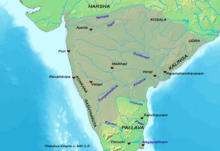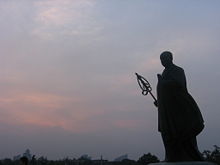Pulakesi II
Pulakesi II (Kannada: ಇಮ್ಮಡಿ ಪುಲಿಕೇಶಿ) (610 - 642 C.E.) is the most famous ruler of the Chalukya dynasty. In his reign the Chalukyas of Badami saw their kingdom extend over most of the Deccan.
Early life and accession
Ereya, who assumed the name Pulakesi on his coronation, had been the son of the Chalukya king Kirtivarman I.[1] When Kirtivarman died in 597, Ereya was still a young boy and Kirtivarman's brother Mangalesa governed the kingdom as regent until Ereya came of age. Mangalesa was a capable ruler and continued expanding the kingdom. When Ereya came of age, desire for power drove Mangalesa to deny prince Ereya his rightful place on the Chalukya throne He sought to perpetuate his own line by making his son heir apparent.
Ereya took shelter in the Bana territory (Kolar), organized an army with the help of his allies and declared war on his uncle. According to an Peddavadagur inscription, Mangalesa was defeated and killed in the battle of Elapattu Simbige. Ereya ascended the Chalukya throne as Pulakesi II and assumed the title Parameshwara.
Emperor Parameshwara
Consolidation of the Chalukya dynasty
Pulakesi had to face several obstacles soon after his coronation.[2] The civil war had given fresh hope to feudatories and adventurers; some of them felt emboldened to throw off their allegiance to the Chalukyas. The Aihole inscription of 634 found in an Aihole Jainlaya conveys the mood of rebellion.[3] Pulakesi had to face the challenge of Appayika and Govinda, perhaps loyal adherents of the defeated Mangalesa. One, or possibly both, had been Mangalesa's son. Pulakesi confronted their army on the banks of the river Bhima. Appayika fled from the battlefield, while Govinda surrendered.
Expansion
After consolidating his position, Pulakesi II organized and enlarged his army. He then embarked upon a series of conquests to expand his dominions. The Aihole inscription dated 634, composed by Pulakesi's court poet Ravikirti, provide accounts of campaigns. The inscription constitutes one of the finest pieces of poetry in Indian literature. Written in Sanskrit language and Hale Kannada script, it is the most important source of information regarding the rule of Pulakesi II.[4]
Conquests in the West
He subjugated the Kadambas of Banavasi, the Gangas of Talakad and the Alupas of South Kanara. He defeated the Mauryas of the Konkan, and the port of Puri (modern Elephanta Island) fell after a naval battle. Victories over the Latas, the Gurjaras and the Malawas followed, resulting in the annexation of the Gujarat area. Those victories have been researched by historians R.C. Majumdar[5] and Sircar. The Ganga ruler Durvinita gave one of his daughters in marriage to Pulakesi, and she became the mother of Vikramaditya I.
Eastern Deccan
Pulakesi next swept over the Panduvamsis in Kosala, followed by victory over the Eastern Gangas of Kalinga and the capture of the fort of Pishtapura (Pithapuram). He subjugated the Vishnukundins and captured the Kunala area in the Vengi region, appointing his brother Kubja Vishnuvardhana (also called Bittarasa) as viceroy of his Eastern territories. Vishnuvardhana eventually founded the Eastern Chalukyas dynasty.
Southern Expedition
Moving further south, Pulakesi II routed the Pallava king Mahendravarman I in the battle of Pullalur, only 25 KM north of the Pallava capital. There a pitched battle was fought, and although Mahendravarman saved his capital, he lost the northern provinces to Pulakesi. The Chalukya king was aided by Durvinita of the Gangas dynasty from the West and the Pandyan king Jayantavarman from the South. The Chalukya army laid siege to the Pallava capital at Kanchipuram, but could not capture the kingdom, so had to return home.
The Chalukya victory over Mahendravarman I was, according to Prof. Nilakanta Sastri, "the first move initiating what developed into one of the persistent lines of conflict in South Indian history."
Battle with Harsha
When Pulakesi II pushed forth up to the Narmada, he came face to face with Harshavardhana of Kanauj who already had the title Uttarapatheshvara (Lord of the North). In a decisive battle fought on the banks of the river Narmada, Harsha lost a major part of his elephant force and had to retreat. The Aihole inscription describes how the mighty Harsha lost his harsha (joy) when he suffered the ignominy of defeat. Pulakesi entered into a treaty with Harsha, with the Narmada River designated as the border between the Chalukya Empire and that of Harshavardhana.
The Chinese traveller Hieun-tsang describes the event thus:
- "Siladityaraja (i.e., Harsha), filled with confidence, himself marched at the head of his troops to contend with this prince (i.e., Pulakesi); but he was unable to prevail upon or subjugate him."
It was indeed a great victory for the Chalukya monarch, who assumed the proud titles of Parameswara (Paramount Overlord), Satyashraya, Prithvivallabha. With this conquest, Pulakesi's control extended completely over Southern India, including Maharashtra and parts of Madhya Pradesh and Gujarat. He received the title Dakshinapatheshvara (Lord of the South) at around the same time. These victories happened between 630 and 634. Since the Lohner plates of Pulakesi II (630) do not speak of his northern victory. Pulakesi II married a princess of the Alupas of South Canara.
Reversals
The last days of Pulakesi II witnessed several reversals to his earlier successes. Pulakesi's ambition prompted him to undertake another expedition against the Pallavas in the hope of achieving more decisive results. However, war had depleted the treasury sufficiently enough to prevent Pulakesi to mount an effective campaign.
The Pallavas had overcome their defeat and Narasimhavarman I had succeeded Mahendravarman I. Pulakesi began his campaign by an attack on the Banas, vassals of the Pallavas. After overrunning them, Pulakesi invaded the Pallava kingdom proper and once more threatened the Pallava Capital. However the Pallava forces under Narasimhavarman defeated the Chalukyas in several battles including one at Manimangalam, east of Kanchipuram. In these battles the Pallava army was assisted by the Sinhalese king Manavarma. Pulakesi's expedition ended in failure. The Pallavas, encouraged by their success, invaded deep into Chalukya territory. The Pallava ruler captured and sacked Vatapi (Badami). Narasimhavarman assumed the title of Vatapikonda (the conqueror of Vatapi). Vatapi remained in Pallava control for twelve years.
Pulakesi's death and legacy
Pulakesi II may have lost his life in one of those encounters against the Pallavas. The thirteen years that followed saw the eclipse of Chalukya power, while Badami remained in the hands of the Pallavas.[6]
Pulakesi exchanged ambassadors with the Shah of Persia Khosrau II. His reception of the Persian ambassador is depicted in one of the paintings in the Ajanta caves. The Chinese traveller Hsuan Tsang, who visited India in the seventh century, wrote admiringly of Pulakesi and his Empire.
Pulakesi was the first ruler in South India to issue gold coinage. Broad and circular in shape, the punch-marked coins had various punches at the edge, and a central punch depicting a Varaha or Boar. The Boar was the royal emblem of the Chalukyas. Contemporary literature cites the gold coins of south India as Varahas.
Pulakesi had five sons, Chandraditya, Adityavarma, Vikramaditya, Jayasimha and Ambera. They fought among themselves after his demise, trying to divide the kingdom into territories for each of themselves. Pulakesi's third son Vikramaditya I became the Chalukya king 642 and attempted to re-unite the kingdom after defeating his brothers.
| Preceded by: Mangalesa |
Chalukyas 610 –642 |
Succeeded by: Vikramaditya I |
See also
- Karnataka
- Badami
Notes
- ↑ Ramkrishna Gopal Bhandarkar. 1895. Early history of the Dekkan down to the Mahomedan conquest (Bombay: Printed at the government central press), p. 49.
- ↑ Robert Sewell. 1884. Lists of inscriptions, and sketch of the dynasties of southern India (Madras: Printed by E. Keys at the Government Press), p. 212.
- ↑ Dineschandra Sircar. 1965. Indian epigraphy (Delhi: Motilal Banarsidass), p. 18.
- ↑ Siegfried Lienhard. 1984. A history of classical poetry, Sanskrit, Pali, Prakrit (Wiesbaden: Harrassowitz), p. 184.
- ↑ Ramesh Chandra Majumdar, Hemchandra Raychaudhuri, and Kalikinkar Datta. 1967. An advanced history of India (London: Macmillan).
- ↑ Narendra Krishna Sinha and Anil Chandra Banerjee. 1963. History of India (Calcutta: A. Mukherjee), p. 199.
ReferencesISBN links support NWE through referral fees
- Bhandarkar, Ramkrishna Gopal. 1895. Early history of the Dekkan down to the Mahomedan conquest. Bombay: Printed at the government central press. OCLC 5578619.
- Kāmat, Sūryanātha. 1980. A concise history of Karnataka: from pre-historic times to the present. Bangalore: Archana Prakashana. OCLC 7796041.
- Lienhard, Siegfried. 1984. A history of classical poetry, Sanskrit, Pali, Prakrit. Wiesbaden: Harrassowitz. ISBN 9783447024259.
- Majumdar, Ramesh Chandra, Hemchandra Raychaudhuri, and Kalikinkar Datta. 1967. An advanced history of India. London: Macmillan. OCLC 611354.
- Nilakanta Sastri, K. A. 1990. A history of South India from prehistoric times to the fall of Vijayanagar. Oxford India paperbacks. Bombay: Oxford University Press. OCLC 35690171.
- Sewell, Robert. 1884. Lists of inscriptions, and sketch of the dynasties of southern India. Madras: Printed by E. Keys at the Government Press. OCLC 5166328.
- Sinha, Narendra Krishna, and Anil Chandra Banerjee. 1963. History of India. Calcutta: A. Mukherjee. OCLC 10977138.
- Sircar, Dineschandra. 1965. Indian epigraphy. Delhi: Motilal Banarsidass. OCLC 1052978.
External Links
- South Indian Inscriptions. Retrieved September 4, 2008.
- History of Karnataka, Mr.Arthikaje. Retrieved September 4, 2008.
[[Category:]]
Credits
New World Encyclopedia writers and editors rewrote and completed the Wikipedia article in accordance with New World Encyclopedia standards. This article abides by terms of the Creative Commons CC-by-sa 3.0 License (CC-by-sa), which may be used and disseminated with proper attribution. Credit is due under the terms of this license that can reference both the New World Encyclopedia contributors and the selfless volunteer contributors of the Wikimedia Foundation. To cite this article click here for a list of acceptable citing formats.The history of earlier contributions by wikipedians is accessible to researchers here:
The history of this article since it was imported to New World Encyclopedia:
Note: Some restrictions may apply to use of individual images which are separately licensed.

